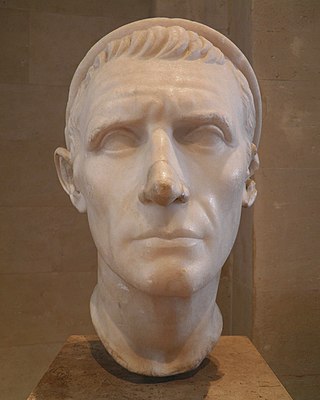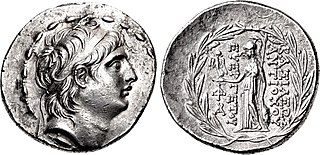
The Seleucid Empire was a Greek state in West Asia that existed during the Hellenistic period from 312 BC to 63 BC. The Seleucid Empire was founded by the Macedonian general Seleucus I Nicator, following the division of the Macedonian Empire originally founded by Alexander the Great.

The 1st century BC, also known as the last century BC and the last century BCE, started on the first day of 100 BC and ended on the last day of 1 BC. The AD/BC notation does not use a year zero; however, astronomical year numbering does use a zero, as well as a minus sign, so "2 BC" is equal to "year –1". 1st century AD follows.
This article concerns the period 69 BC – 60 BC.
Year 92 BC was a year of the pre-Julian Roman calendar. At the time it was known as the Year of the Consulship of Pulcher and Perperna and the First Year of Zhenghe. The denomination 92 BC for this year has been used since the early medieval period, when the Anno Domini calendar era became the prevalent method in Europe for naming years.
Year 153 BC was a year of the pre-Julian Roman calendar. At the time it was known as the Year of the Consulship of Nobilior and Luscus. The denomination 153 BC for this year has been used since the early medieval period, when the Anno Domini calendar era became the prevalent method in Europe for naming years.
Year 164 BC was a year of the pre-Julian Roman calendar. At the time it was known as the Year of the Consulship of Torquatus and Longinus. The denomination 164 BC for this year has been used since the early medieval period, when the Anno Domini calendar era became the prevalent method in Europe for naming years.

Antiochus III the Great was a Greek Hellenistic king and the 6th ruler of the Seleucid Empire, reigning from 222 to 187 BC. He ruled over the region of Syria and large parts of the rest of western Asia towards the end of the 3rd century BC. Rising to the throne at the age of eighteen in 222 BC, his early campaigns against the Ptolemaic Kingdom were unsuccessful, but in the following years Antiochus gained several military victories and substantially expanded the empire's territory. His traditional designation, the Great, reflects an epithet he assumed. He also assumed the title Basileus Megas, the traditional title of the Persian kings. A militarily active ruler, Antiochus restored much of the territory of the Seleucid Empire, before suffering a serious setback, towards the end of his reign, in his war against Rome.

Antiochus IV Epiphanes was a Greek Hellenistic king who ruled the Seleucid Empire from 175 BC until his death in 164 BC. He was a son of King Antiochus III the Great. Originally named Mithradates, he assumed the name Antiochus after he ascended the throne. Notable events during Antiochus's reign include his near-conquest of Ptolemaic Egypt, his persecution of the Jews of Judea and Samaria, and the rebellion of the Jewish Maccabees.

Antiochus VII Euergetes, nicknamed Sidetes, also known as Antiochus the Pious, was ruler of the Hellenistic Seleucid Empire who reigned from July/August 138 to 129 BC. He was the last Seleucid king of any stature. After Antiochus was killed in battle, the Seleucid realm was restricted to Syria.

Antiochus XII Dionysus Epiphanes Philopator Callinicus was a Hellenistic Seleucid monarch who reigned as King of Syria between 87 and 82 BC. The youngest son of Antiochus VIII and, most likely, his Egyptian wife Tryphaena, Antiochus XII lived during a period of civil war between his father and his uncle Antiochus IX, which ended with the assassination of Antiochus VIII in 96 BC. Antiochus XII's four brothers laid claim to the throne, eliminated Antiochus IX as a claimant, and waged war against his heir Antiochus X.

Antiochus X Eusebes Philopator was a Seleucid monarch who reigned as King of Syria during the Hellenistic period between 95 BC and 92 BC or 89/88 BC. He was the son of Antiochus IX and perhaps his Egyptian wife Cleopatra IV. Eusebes lived in a period during which there was a general disintegration of Seleucid Syria characterized by civil wars, foreign interference by Ptolemaic Egypt and incursions by the Parthians. Antiochus IX was killed in 95 BC at the hands of Seleucus VI, the son of his half-brother and rival Antiochus VIII. Antiochus X then went to the city of Aradus where he declared himself king. He avenged his father by defeating Seleucus VI, who was eventually killed.

Philip I Epiphanes Philadelphus was a Hellenistic Seleucid monarch who reigned as the king of Syria from 94 to either 83 or 75 BC. The son of Antiochus VIII and his wife Tryphaena, he spent his early life in a period of civil war between his father and his uncle Antiochus IX. The conflict ended with the assassination of Antiochus VIII; Antiochus IX took power in the Syrian capital Antioch, but soon fell in battle with Antiochus VIII's eldest son Seleucus VI.

Antiochus XIII Philadelphus, known as Asiaticus, (Ἀσιατικός) was the penultimate ruler of the Seleucid kingdom.

Philip II Philoromaeus or Barypous, a ruler of the Hellenistic Seleucid Empire, was the son of the Seleucid king Philip I Philadelphus, and the last Seleucid king.

The Hasmonean dynasty was a ruling dynasty of Judea and surrounding regions during classical antiquity, from c. 140 BCE to 37 BCE. Between c. 140 and c. 116 BCE the dynasty ruled Judea semi-autonomously in the Seleucid Empire, and from roughly 110 BCE, with the empire disintegrating, Judea gained further autonomy and expanded into the neighboring regions of Perea, Samaria, Idumea, Galilee, and Iturea. Some modern scholars regard the Hasmonean realm as an independent Israel. The Hasmonean rulers took the Greek title basileus. Forces of the Roman Republic conquered the Hasmonean kingdom in 63 BCE and made it into a client state; Herod the Great displaced the last reigning Hasmonean client-ruler in 37 BCE.

Roman Syria was an early Roman province annexed to the Roman Republic in 64 BC by Pompey in the Third Mithridatic War following the defeat of King of Armenia Tigranes the Great.

Cleopatra II Selene was the Queen consort of Egypt from 115 to 102 BC, the Queen consort of Syria from 102–92 BC, and the monarch of Syria from 82 to 69 BC. The daughter of Ptolemy VIII Physcon and Cleopatra III of Egypt, Cleopatra Selene was favoured by her mother and became a pawn in Cleopatra III's political manoeuvres. In 115 BC, Cleopatra III forced her son Ptolemy IX to divorce his sister-wife Cleopatra IV, and chose Cleopatra Selene as the new queen consort of Egypt. Tension between the king and his mother grew and ended with his expulsion from Egypt, leaving Cleopatra Selene behind; she probably then married the new king, her other brother Ptolemy X.

Commagene was an ancient Greco-Iranian kingdom ruled by a Hellenized branch of the Iranian Orontid dynasty that had ruled over Armenia. The kingdom was located in and around the ancient city of Samosata, which served as its capital. The Iron Age name of Samosata, Kummuh, probably gives its name to Commagene.
Sampsiceramus I was the founding Priest-King of the Emesene dynasty who lived in the 1st century BC and was a tribal chieftain or Phylarch.














